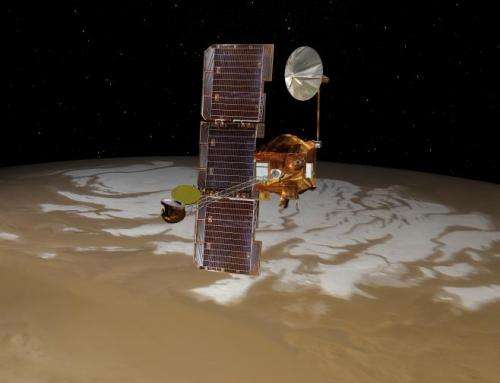Mars Odyssey orbiter out of precautionary 'safe mode'

(Phys.org) -- NASA's Mars Odyssey orbiter has been taken out of a protective status called safe mode. Remaining steps toward resuming all normal spacecraft activities will probably be completed by next week.
Odyssey resumed pointing downward toward Mars on Saturday, June 16, leaving the Earth-pointed "safe mode" status that was triggered when one of its three primary reaction wheels stuck for a few minutes on June 8, Universal Time (June 7, Pacific Time). Mission controllers put the orbiter's spare reaction wheel into use in control of Odyssey's orientation while pointed downward, or nadir.
"Attitude control in nadir pointing is being maintained with the use of the replacement wheel, and the suspect wheel has been taken out of use," said Odyssey Project Manager Gaylon McSmith of NASA's Jet Propulsion Laboratory, Pasadena, Calif.
Controllers will continue characterizing the performance of the replacement wheel in coming days while assessing which other activities of the spacecraft, besides nadir pointing, can be performed reliably with reaction-wheel control of attitude. The spacecraft can also use thrusters for attitude control, though that method draws on the limited supply of propellant rather than on electricity from the spacecraft's solar array.
In returning to full service, Odyssey will first resume its communication relay function for NASA's Mars Exploration Rover Opportunity, and then will resume the orbiter's own scientific observations of Mars. As a priority, activities will resume for preparing Odyssey to serve as a communications relay for NASA Mars Science Laboratory mission.
Like many other spacecraft, Odyssey uses a set of three reaction wheels to control its attitude, or which way it is facing relative to the sun, Earth or Mars. Increasing the rotation rate of a reaction wheel inside the spacecraft causes the spacecraft itself to rotate in the opposite direction. The configuration in use from launch in 2001 until three days ago combined the effects of three wheels at right angles to each other to provide control in all directions. The replacement wheel is skewed at angles to all three others so that it could be used as a substitute for any one of them.
Odyssey has worked at Mars for more than 10 years, which is longer than any other Mars mission in history. Besides conducting its own scientific observations, it serves as a communication relay for robots on the Martian surface. NASA plans to use Odyssey and the newer Mars Reconnaissance Orbiter as communication relays for the Mars Science Laboratory mission during the landing and Mars-surface operations of that mission's Curiosity rover.
Provided by NASA




















